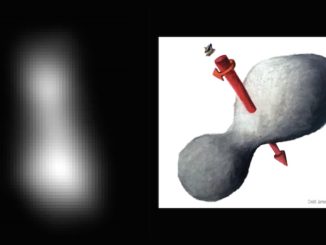STORY WRITTEN FOR CBS NEWS & USED WITH PERMISSION
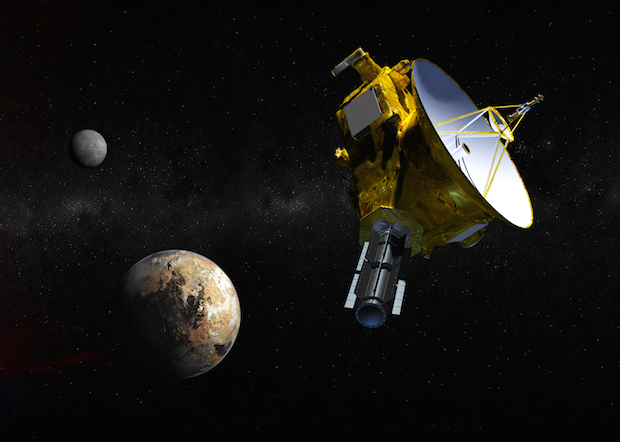
Three billion miles and nine-and-a-half years from Earth, NASA’s New Horizons probe is racing toward a historic July 14 flyby of Pluto, providing the first close-up views of the most famous denizen of the Kuiper Belt, a vast hinterland where uncounted remnants of the solar system’s birth orbit in frozen solitude.
Famously demoted from planethood, Pluto, its large moon Charon and its four other known satellites have been elevated to rock star status in recent weeks as New Horizons has hurtled ever closer, beaming back increasingly sharp pictures of a remote world on the outer limits of humanity’s reach.
Recent photos have revealed an apparent polar cap, huge dark spots stretched along the reddish world’s equator and even surface features on Charon, a Texas-size moon that orbits Pluto in gravitational lockstep every 6.4 days.
But the best is yet to come.
For principal investigator Alan Stern and a dedicated team of scientists and engineers who first proposed a Pluto mission back in 1989, the coming flyby represents the “capstone” of the initial reconnaissance of the solar system, the first visit to a new world since Voyager 2’s flybys of Uranus and Neptune in 1986 and 1989.
“It’s taken a long time to get this thing funded and built and flown across the solar system, but in the next few (days), we’re going to rock people’s socks, and I think if we do it right, we’ll have the eyes of the world on us,” Stern, a senior scientist at the Southwest Research Institute, told CBS News.
The $720 million mission is reminiscent of “the 1960s or 70s, when everything was brand new exploration, but done with 21st century technology. And it’s been a generation since Voyager. Half the people in the United States are too young to remember Voyager.”
“They’ve never seen what you saw as a boy — Mars go from a point of light to a planet. Jupiter and its moons do the same thing, then Saturn, then Uranus, then Neptune. They’ve never seen anything like this in any country around the world.
“So we know we’re going to really fire people up, they’re going to see this place, Pluto, become a real, complicated, frontier world. I hope we can enthuse kids to go into science and math and engineering, just to say that is a cool thing we did!”
Mike Brown, a planetary astronomer who led the discovery of several Pluto-like worlds in the Kuiper Belt and a leading proponent of the “Pluto is not a planet” school of thought, said the New Horizons mission represents “our only chance to see what any of the objects out there are like, and this will inform everything we think about all the objects out there.”
“I’m actually a lot more excited now than I even was when New Horizons was being conceived,” Brown, who is not part of the New Horizons project, said in an interview. “Way back then, Pluto was just this oddball at the edge of the solar system. And now, we know it’s just one of many things like it that we’re going to learn about, this whole class of objects, which is an exciting thing to get to do.”
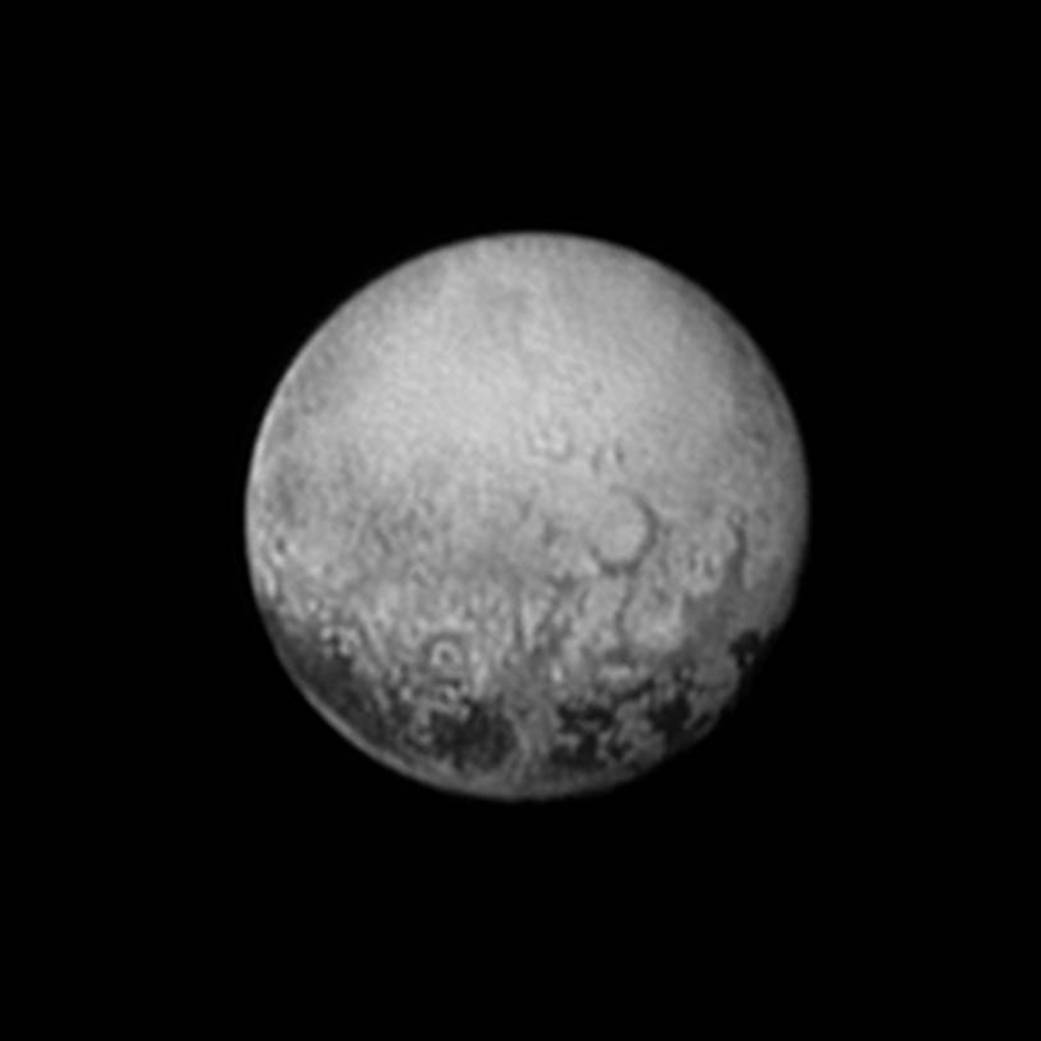
Built by the Johns Hopkins University Applied Physics Laboratory, New Horizons will make its closest approach to Pluto at 7:49:57 a.m. EDT (GMT-4) on July 14, passing within about 7,750 miles of the dwarf planet’s surface at more than 31,000 miles per hour. The spacecraft’s cameras will be able to resolve surface features as small as a softball field.
Fourteen minutes later, the spacecraft will make its closest approach to Charon, a more distant 17,900 miles from the moon’s surface.
In a remarkable feat of celestial navigation, New Horizons will fly into Pluto’s shadow 47 minutes and 28 seconds after the Charon flyby, orienting itself so its high-gain antenna and instruments can record how Pluto’s tenuous nitrogen-methane atmosphere affects sunlight and radio signals from Earth as they pass through.
“After we pass by Pluto, we then fly into Pluto’s shadow at the same time while we’re looking at radio beams coming up from the Deep Space Network … measuring the structure of Pluto’s atmosphere, the temperature and the mass of Pluto’s atmosphere,” said Hal Weaver, the New Horizons project scientist.
“At the same time, the ultraviolet spectrograph, the Alice instrument, will be observing the sun and by looking at the absorption of sunlight as we pass behind Pluto’s atmosphere, we get the signature of the composition of Pluto’s upper atmosphere.”
Just one minute and two seconds after entering the shadow cone, New Horizons will move back into sunlight and one hour and 25 minutes after that, the spacecraft will pass through the shadow of Charon, again searching for evidence of an atmosphere.
Throughout the approach and departure, New Horizons’ sensitive cameras and other instruments will study the other known moons — Hydra, Nix, Kerberos and tiny Styx — and will attempt to map Pluto’s dark side, illuminated by sunlight reflected from Charon.
They also will search for any signs of cryogenic geysers like those seen on Neptune’s moon Triton, which many astronomers believe is a captured Kuiper Belt body. Pluto may harbor an ocean of liquid water below its icy crust.
“This is a scientific wonderland,” Stern told reporters earlier this year. “It is a binary (planet). Pluto and it’s large, Texas-size moon Charon, half its size, are like nothing we have ever visited in the history of planetary exploration. And surrounding that binary is a circumbinary system of at least four more, much smaller moons.”
Despite its vast distance from the sun and a surface temperature around 387 degrees below zero Fahrenheit, Pluto is “a very complex body,” Stern said.
“It has an atmosphere, it has seasons, the surface markings have been moving over time, probably indicating shifting snows and some sort of process of exchange between the atmosphere and the surface. We’ve seen the atmospheric pressure double or perhaps triple over time, we know that it’s rocky on the inside and icy on the outside.”
The presence of nitrogen, carbon monoxide and methane “make for probably the most complex system of interactions we have ever seen in the history of exploration between surface and atmosphere,” Stern said.
And then there’s Charon, which Stern called “the rising star of this mission.”
“It has no volatiles on its surface, only water ice,” he said. “It has a much less rocky interior. To our knowledge, it has no atmosphere. But there are tantalizing signs of surface activity. … We’re going to see which of those things are actually the case and what this pair has in store for us.”
At a distance of more than three billion miles and moving ever more distant, using 12-watt radio transmitters and a relatively small antenna, it will take New Horizons some 16 months to play back all of its recorded data.
“Although the spacecraft will be long gone from the Pluto system after July, we will be making discoveries as a science team and communicating them to the world for 16 months as new data sets come to the ground, as if we were still there in orbit,” Stern said. “This is really a different mode of flyby than has ever been done because we have the capability to collect a large amount of data.”
And when its done with Pluto, New Horizons will continue its lonely mission, flying past at least one more Kuiper Belt object in 2019 before departing the solar system and heading out into interstellar space.
SEARCHING FOR “PLANET X”
At the turn of the 20th century, Neptune was the eighth and outermost known planet. But astronomer Percival Lowell, founder of the Lowell Observatory in Flagstaff, Arizona, believed a ninth planet likely lurked in the darkness beyond and he believed it could be found by looking for subtle gravitational perturbations in the orbits of Uranus and Neptune.
Three unsuccessful searches for “Planet X” were carried out before Lowell died in 1916. But the Lowell Observatory continued the search, hiring amateur Clyde Tombaugh to carry out painstaking observations.
Taking pictures of the same area of the night sky several days apart, Tombaugh used an instrument called a blink comparator to examine two plates mounted side by side, switching back and forth between the two views to look for anything that appeared to move against the fixed background stars.
Astronomers believed there were two likely areas of the sky to examine for a ninth planet but as it turned out their calculations were flawed. Even so, by a combination of luck and diligence, Tombaugh finally succeeded on Feb. 18, 1930. He had found Lowell’s ninth planet.
“In the little cluster of orbs which scampers across the sidereal abyss under the name of the solar system there are, be it known, nine instead of a mere eight, worlds,” the Associated Press reported. “Way out beyond Neptune, tagging bashfully behind its brothers, the new planet’s exact whereabouts, size and age are still unknown and it has not even a name.”
But Pluto, as it came to be known, turned out to be much smaller than the observatory’s founder expected, and it was so far away little could be discerned about its nature beyond the basics of its orbit.
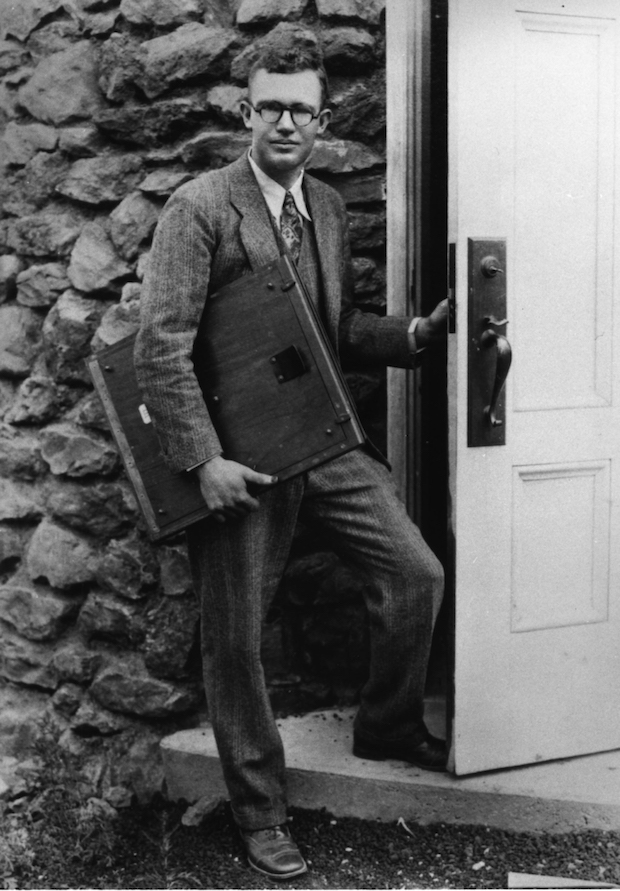
Over the years, astronomers filled in many of the blanks, finding that Pluto circles the sun in a 247.7-year elliptical orbit tilted 17 degrees to the plane of the other planets, an orbit carrying it as close as 2.8 billion miles from the sun and as far as 4.6 billion miles. Between 1979 and 1999, Pluto was closer to the sun than Neptune.
The ice dwarf is tipped over on its side and has a diameter of about 1,470 miles. Gravity is about 6 percent of Earth’s and surface temperatures are as low as 387 degrees below zero Fahrenheit. Astronomers have detected spectroscopic signs of nitrogen, carbon monoxide, methane and ice on the surface.
The distant world has an extremely thin atmosphere composed of nitrogen with small amounts of methane, carbon monoxide and other hydrocarbons.
For nearly 50 years, Pluto was little more than a dim point of light on photographic plates and, eventually, CCD detectors. But in 1978, U.S. Naval Observatory astronomer James Christy discovered a large moon orbiting Pluto. He named it Charon, after his wife Charlene. The name also refers to the ferryman of the dead in Greek mythology.
Pluto and Charon whirl about each other every 6.4 days at a distance of about 12,200 miles, turning in gravitational lockstep and always keeping the same face toward each other.
At 745 miles across, Charon is about nearly half the size of Pluto and the two orbit a common center of gravity, or barycenter, well above Pluto’s surface. For that reason, Pluto is viewed as a “binary planet,” the only such worlds yet discovered. Four other, much smaller moons, were discovered by the Hubble Space Telescope in 2005, 2011 and 2012.
The origin of the Pluto-Charon system is not known with certainty, but scientists believe a large body crashed into Pluto shortly after the solar system’s formation 4.6 billion years ago. Material from the impactor and Pluto was blown into space and later coalesced to form Charon. Pluto’s other four moons are thought to be made up of surviving remnants of the great crash.
In more general terms, Pluto is now thought to be the largest, or one of the largest, bodies making up the Kuiper Belt, a vast realm stretching two billion miles beyond the orbit of Neptune where debris left over from the formation of the solar system slowly orbits.
The existence of the Kuiper Belt was confirmed in 1992 when the first Kuiper Belt Object, or KBO, was discovered, a body 10,000 times fainter than Pluto. Since then, more than 1,000 icy KBOs have been discovered, ranging from 30 to more than 1,200 miles across. One of them, Eris, appears to be slightly larger than Pluto.
All told, the Kuiper Belt may include more than 100,000 bodies with diameters greater than 60 miles.
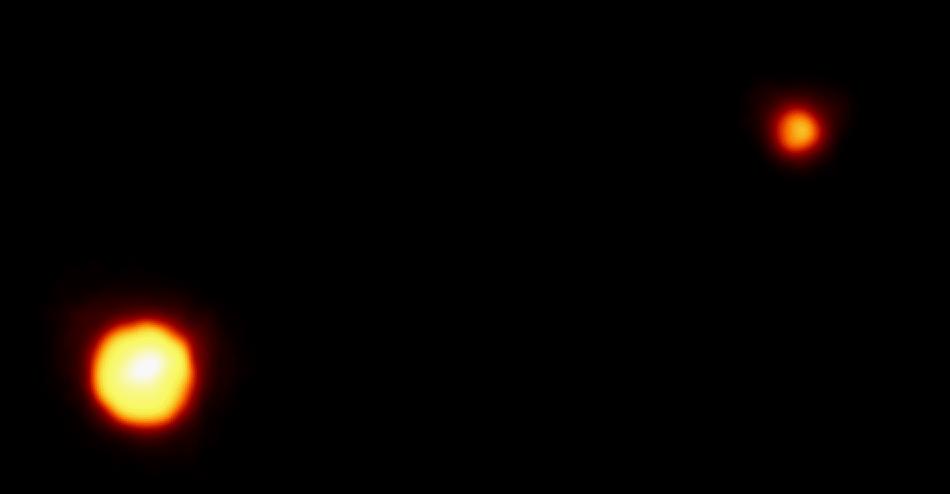
Planetary scientists now view the solar system as made up of three distinct zones. Closest to the sun are the rocky terrestrial planets: Mercury, Venus, Earth and Mars. Then come the gas giants, Jupiter, Saturn, Uranus and Neptune. And now comes the Kuiper Belt and its most famous member.
Pluto was known as an “ice dwarf” even before the International Astronomical Union officially changed its designation from “planet” to “dwarf planet” in 2006. And despite its famous — or infamous — demotion, Pluto has lost none of its luster.
“Pluto is a brand now, it’s essentially a brand,” Stern said. “Everybody knows what it is, and there’s intense interest in this. It’s small and diminutive, that may be part of it. It’s on the far frontier, that’s part of it. It’s the one that everybody and their kid’s textbooks, when you got to Pluto, it was all question marks, it didn’t have a picture, didn’t know the size, didn’t know the atmosphere, didn’t know anything.”
All of that’s about to change.
NEW HORIZONS’ COMPLEX CHOREOGRAPHY
New Horizons’ flyby of Pluto is an extraordinarily complex undertaking, one that requires split-second timing as the spacecraft autonomously carries out hundreds of observations while streaking through the Pluto-Charon system at more than 31,000 mph.
At some three billion miles from Earth, the spacecraft is far beyond any sort of real-time guidance.
Because New Horizons’ instruments cannot be independently aimed, the entire spacecraft must constantly re-orient itself to make the desired science observations as it moves through the Pluto system, turning this way and that, following a complex set of commands radioed up from Earth before the encounter.
And while the flyby science is being carried out, New Horizons’ high-gain antenna will not be pointed at Earth. The spacecraft must operate autonomously, storing its collected images and other data on solid-state recorders for later transmission to Earth.
On July 14, no data is expected on Earth beyond a signal around 9 p.m. that evening telling flight controllers the spacecraft survived the flyby. The first close-approach images are expected the next day. But the full set of high-resolution images and data is expected to take 16 months to transmit to Earth.
“The craft will be operating itself, we won’t be joy-sticking it from mission control, it will have what’s called a command sequence, a program of instructions,” Stern said. “They’ve been simulated on the ground, and we’ve even put that command sequence on the spacecraft in flight and had it run through the Pluto encounter out in the middle of nowhere. So it’s pretty well rehearsed.”
All in all, he said, “there are something more than a thousand scientific observations in that sequence among the seven instruments. Pluto, five moons, there are a lot of targets, a lot of data sets we collect.”
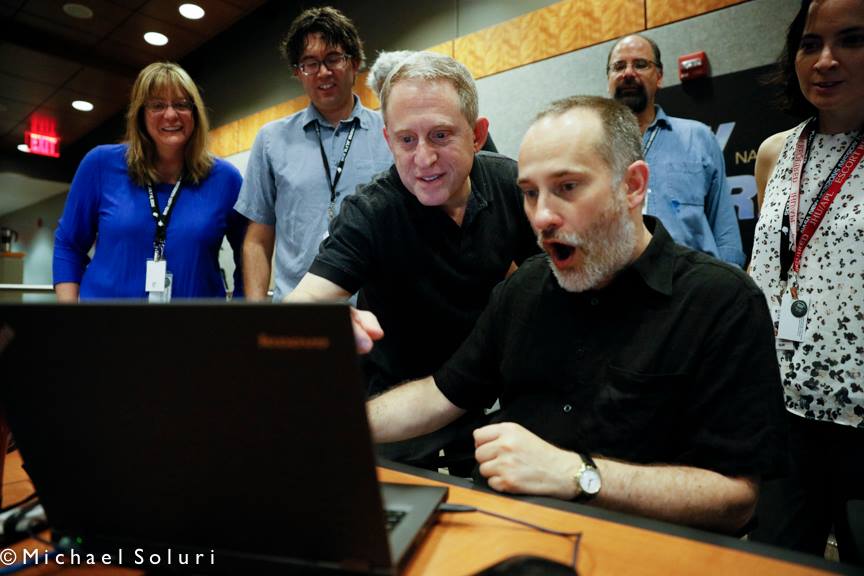
And timing is critical. For the command sequence to make the desired observations, New Horizons must fly through an imaginary close-approach target in space measuring 60 by 90 miles within a window just 100 seconds long. And hitting that box on time means understanding exactly where Pluto and the spacecraft are with respect to each other.
Over the past several weeks, New Horizons’ Long-Range Reconnaissance Imager, or LORRI, camera was used to precisely measure Pluto’s position with respect to background stars, helping scientists pin down the dwarf planet’s exact location and orbital track. The camera also was used to look for uncharted moons or even rings that might pose a threat to the spacecraft.
No such threats were identified and on June 29, a final 23-second trajectory correction maneuver was carried out to ensure the proper flyby geometry and timing.
“So we’re flying three billion miles, we have to hit a target 60 by 90 miles and we have to hit it within 100 seconds after nine-and-a-half years,” said Glen Fountain, the New Horizons project manager. “That’s the kind of precision we have to navigate to.”
“Not only do we have to hit this one point in the system as we fly by at closest approach, but we have to also fly through in such a way, we have to thread the needle so that we pass through the shadow of Pluto and then the shadow of Charon. Just to make it a little more difficult! … And with that, we collect the data and we turn around and send it home.”
But there are no guarantees.
On July 4, an unexpected processing overload on the spacecraft’s primary flight computer prompted its autopilot to switch over to a backup computer, putting the probe in “safe mode” and interrupting communications with Earth. The problem was quickly diagnosed and normal operations resumed two days later.
But the loss-of-contact, however brief, reminded everyone of the risks involved with operating a spacecraft on the edge of the solar system.
“We are so far away, it’s a nine-hour round-trip light time, so the spacecraft has to operate on its own,” Fountain said. “We can’t rely upon the kind of ground intervention, as good as it is, to be able to do anything.”
Instead, starting seven days out, New Horizons began operating with “encounter mode” software logic for the make-or-break flyby.
“Instead of going safe as it did (July 4) the spacecraft will automatically return to the preprogrammed timeline to continue gathering data,” Fountain said. “We will have that as our belt and suspenders as we go through the encounter itself.”
But New Horizons is a one-shot deal. It cannot slow down or come back for a second chance. Even before the recent glitch, Weaver said “the stress level is pretty high. The damn thing better work, too!”
“We’ve done as much as we can. But you’re only as strong as your weakest link. But things have worked so beautifully for the past nine years, it seems like it will continue to work and we’ll be successful. But it remains to be seen.”
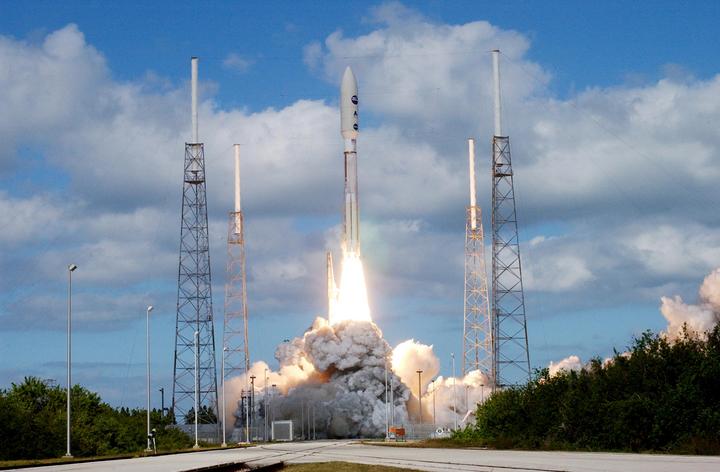
PACKING LIGHT FOR A VERY LONG TRIP
New Horizons began its long journey on Jan. 19, 2006, blasting off atop the most powerful version of a United Launch Alliance Atlas 5 rocket.
The lightest payload ever launched by an Atlas 5, a rocket normally used to boost heavy spy satellites and large NASA payloads into orbit, New Horizons was propelled to a record departure velocity of 36,000 mph — 10 miles per second — fast enough to cross the moon’s orbit in just nine hours. It took the Apollo astronauts more than three days.
New Horizons crossed the orbit of Mars less than three months after launch, raced through the asteroid belt and got to Jupiter in a record 13 months for a velocity-boosting gravity-assist flyby that shaved 3.7 years off the trip. The Jupiter flyby also gave the science team an opportunity to thoroughly test the probe’s instruments.
Once past Jupiter, New Horizons spent two thirds of the remaining voyage to Pluto — 1,873 days — in electronic hibernation, periodically waking up and phoning home to downlink health data and to receive software updates.
The engineering team took advantage of the down time to upload and carry out a full-scale dress rehearsal of the Pluto flyby, re-orienting the spacecraft and operating its instruments exactly as required during the real thing.
And then it went back to sleep, all the while covering more than three-quarters of a million miles per day. All told, the trip took nine-and-a-half years.
To put that that immense distance in perspective, imagine the sun the size of a quarter on the goal line of a football stadium. At that scale, Earth, just nine-thousandths of an inch across, would be three yards away. Pluto would be an invisible speck 18 yards beyond the far goal line.
To even consider such a voyage, mission planners knew they had to pack as much science capability as possible into a very lightweight, low-power package. Every pound counted.
“This is a small, compact, highly advanced spacecraft, a real 21st century exploration spacecraft with tremendous capability,” Stern said. “If you weighed all seven instruments aboard New Horizons, the combined weight of these seven very advanced instruments is less than just the camera on the Cassini Saturn orbiter.
“And if they were all running at once, they would draw only 28 watts, about half a standard 60-watt light bulb. Isn’t that amazing? I never get over that. It’s a real tribute to the engineers.”
New Horizons is a lightweight compared to the school bus-sized Cassini spacecraft, measuring just 27-by-83-by-108 inches and weighing 1,054 pounds at launch, of which 170 pounds was hydrazine maneuvering fuel. It’s roughly triangular and about the size of a baby grand piano.
At Pluto’s enormous distance from the sun, solar panels are not a viable option. Instead, New Horizons relies on a single radioisotope thermoelectric generator, or RTG, for electrical power, using thermocouples and the heat produced by the decay of plutonium 238 dioxide to generate electricity.
Seven state-of-the-art science instruments are on board, including a radio system that will be used to both communicate with Earth and to collect valuable data about Pluto’s tenuous atmosphere. The instruments typically operate on less power than a night light – two to 10 watts each. Recalling “The Honeymooners” TV series and Ralph Kramden’s frequent outbursts of “to the moon, Alice,” two of the instruments are named Ralph and Alice.
Operating more than 30 times farther from the sun than Earth, New Horizons is built like a thermos bottle and insulated to retain the heat generated by its electrical systems. Internal temperatures between 50 and 85 degrees Fahrenheit are expected throughout the mission, but small heaters are available just in case it gets colder than expected.
The instruments are:
— Alice: A 10-pound ultraviolet imaging spectrometer built by the Southwest Research Institute to study the structure and composition of Pluto’s atmosphere. It also will be used to look for signs of a charged ionosphere around Pluto and any traces of an atmosphere around Charon.
— Ralph: A 23-pound telescope/camera system developed by Ball Aerospace Corp., NASA’s Goddard Space Flight center and the Southwest Research Institute that includes a multi-spectral visible-light camera with seven black-and-white and color CCD detectors and a single infrared channel for spectroscopic studies.
Operating in light 1,000 times dimmer than on Earth, Ralph will photograph the sunlit surfaces of Pluto and Charon, providing stereoscopic views, measuring the temperature and mapping abundances of nitrogen, methane, carbon monoxide and water ice. In black-and-white mode, the camera will be able to discern surface features three-tenths of a mile across (0.9 miles across in color mode and 4.3 miles in infrared mode).
— Radio Science Experiment (REX): This is a 3.5-ounce circuit board incorporated in the spacecraft’s radio system that was developed by Johns Hopkins and Stanford University. As the spacecraft flies behind Pluto and Charon, radio waves from Earth will be bent slightly as they pass through atmospheric gases. By characterizing those subtle changes, scientists will be able to gain insights into atmospheric temperature and pressure.
— LORRI (Long-Range Reconnaissance Imager): A 19-pound digital camera equipped with an 8.2-inch telescope serving as a telephoto lens that was used for optical navigation on the way to Pluto. At close approach, LORRI, developed by Johns Hopkins, should be capable of detecting surface features as small as 82 feet across.
— SWAP (Solar Wind at Pluto): Developed by the Southwest Research Institute, SWAP will study how Pluto interacts with the solar wind. Scientists believe Pluto loses about 165 pounds of its atmosphere every second. That material is then ionized by sunlight and carried away on the solar wind.
— PEPSSI (Pluto Energetic Particle Spectrometer Science Investigation): A 3.3-pound spectrometer developed by Johns Hopkins to study material escaping from Pluto’s atmosphere as well as the atmosphere itself.
— SDC (Student Dust Counter): The only instrument that will remain on for the duration of the New Horizons mission, the SDC was developed by students at the University of Colorado at Boulder to measure microscopic dust grains in interplanetary space.
“By the time we are done, we will have mapped Pluto and Charon and the small moons for their geology,” Stern said. “We will have mapped their surface temperatures and their surface compositions. We will measure Pluto’s atmosphere, determine its structure, its escape rate and its composition.
“We will address whether Pluto or Charon have interior oceans, and they might. We will search for new satellites and possible rings in the system and we’ll do more. There’s going to be a rich variety of datasets about this strange and mysterious system.”
But Pluto is not the end of the road for New Horizons. Mission managers are studying two KBOs along the spacecraft’s trajectory and hope to fly past at least one of them in 2019. After that, the spacecraft will move on into interstellar space, leaving humanity behind forever.
Fittingly, it will not be alone.
The spacecraft is carrying a CD-ROM with the names of 434,000 enthusiasts, photos of the New Horizons project personnel, quarters from Florida, where the probe was launched, and Maryland, where it was built, and a small piece of Burt Rutan’s SpaceShipOne, the first privately-funded manned spacecraft.
And mounted on the side of New Horizons is a small container housing some of the ashes of Clyde Tombaugh.
“Interned herein are remains of American Clyde W. Tombaugh,” the inscription reads. “Discoverer of Pluto and the solar system’s ‘third zone.’ Adelle and Muron’s boy. Patricia’s husband, Annette and Alden’s father, astronomer, teacher, punster and friend. Clyde W. Tombaugh (1906 — 1997)”


